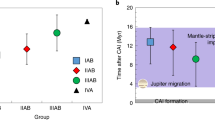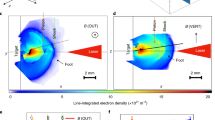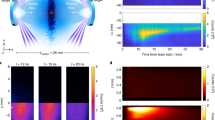Abstract
Cooling processes will weaken the bow shock that is expected to form when the solar wind plasma encounters a gassy comet. As the supersonic wind penetrates the comet's outer coma, accreting freshly ionized cometary atoms and molecules, it needs a shock to adjust to the inner subsonic conditions. The cometary ions, implanted in the plasma stream, are accelerated by the associated fields and take up much of the decrease in streaming energy. The subsonic flow in comets is distinguished by strong cooling, effected primarily through ion–molecule reactions between the energetic implanted ions and the neutral gas coma. We argue here that such cooling can cause complete decay of the shock's flanks, as probed by the ICE (International Cometary Explorer) spacecraft at comet Giacobini–Zinner.
This is a preview of subscription content, access via your institution
Access options
Subscribe to this journal
Receive 51 print issues and online access
$199.00 per year
only $3.90 per issue
Buy this article
- Purchase on Springer Link
- Instant access to full article PDF
Prices may be subject to local taxes which are calculated during checkout
Similar content being viewed by others
References
Biermann, L., Brosowski, B. & Schmidt, H. U. Sol. Phys. 1, 254–284 (1967).
Wallis, M. K. & Ong, R. S. B. Planet. Space Sci. 23, 713–721 (1975).
Wallis, M. K. in Study of Travelling Interplanetary Phenomena (eds Shea, M. A. et al.) 279–289 (Reidel, Dordrecht, 1976).
Shapiro, A. H. The Dynamics and Thermodynamics of Compressible Fluid Flow Ch. 8 (Ronald, New York, 1953).
Wallis, M. K. Planet. Space Sci. 21, 1647–1660 (1973).
Brosowski, B. & Wegmann, R. Meth. Verfahren math. Phys. 8, 125–145 (1973).
Biermann, L., Lust, Rh. & Wegmann, R. Astronautica Acta Suppl. 18, 113–118 (1974).
Galeev, A. A. & Lipatov, L. S. Adv. Space Sci. 4 ( No. 9), 229–237 (1984).
Lipatov, L. S. Kosmich. Issled. 23, 158–166 (1985).
Galeev, A. A., Cravens, T. E. & Gombosi, T. I. Astrophys. J. 289, 807–819 (1985).
Wallis, M. K. & Johnstone, A. D. in Cometary Exploration Vol. 1 (ed. Gombosi, T. I.) 307–311 (CRIP, Budapest, 1983).
Mendis, D. A. & Houpis, H. L. F. Rev. Geophys. Space Phys. 20, 885–928 (1982).
Lui, A. T. Y., Goodrich, C. C., Mankofsky, A. & Papadopoulos, K. AMPTE Sci. Preprint 31 (Preprint 85–06, Johns Hopkins University, 1985).
Courant, R. & Friedrichs, K. O. Supersonic Flow and Shock Waves Ch. 4 (Interscience, New York, 1948).
Wallis, M. K. & Dryer, M. Astrophys. J. 205, 895–899 (1976).
Yeomans, D. K. & Brandt, J. C. The Comet Giacobini–Zinner Handbook (NASA/JPL, Pasadena, California, 1985).
ICE Plasma Instrument, Prospectus (1984).
Cowley, S. W. Nature 317, 381 (1985).
Author information
Authors and Affiliations
Rights and permissions
About this article
Cite this article
Wallis, M., Dryer, M. Decay of the cometary bow shock. Nature 318, 646–647 (1985). https://doi.org/10.1038/318646a0
Received:
Accepted:
Issue Date:
DOI: https://doi.org/10.1038/318646a0
Comments
By submitting a comment you agree to abide by our Terms and Community Guidelines. If you find something abusive or that does not comply with our terms or guidelines please flag it as inappropriate.



